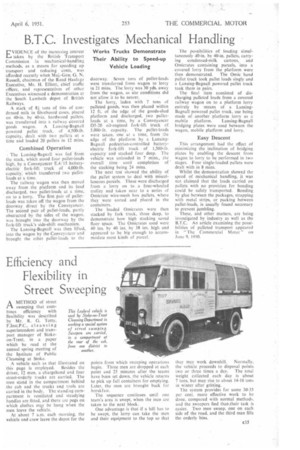B.T.C. Investigates Mechanical Handling
Page 53

If you've noticed an error in this article please click here to report it so we can fix it.
Works Trucks Demonstrate Their Ability to Speed-up Vehicle Loading
• EVIDENCE of the Increasing interest taken by the British Transport Commission iLl mechan ical-ha idling , methods, as a means for speeding up transport and reducing Costs, was afforded recently when Maj.-Gen: G. N. Russell, chairman of the Road Haulage Executive, Mr. H. Elliott, chief traffic officer, and representatives of other Executives witnessed a demonstration at the South Lambeth depot of British Railways.
A stack of 81 tons of tins of condensed milk in fibreboard cases. placed on 40-in, by 40-in, hardwood pallets. was transferred into a railway covered goods wagon. A Lansing-Bagna II powered pallet truck. of 4,500-lb. capacity. dealt with two pallets at a time and loaded 20 pallets in 12 mins.
Combined Operation
• The Lansing-Bagnall was fed from the stack, which stood four pallet-loads high, by a Conveyancer E.4/15 batteryelectric fork-lift truck of 4,000-lb. capacity, which transferred two Pallettoads at a time.
The railway wagon was then moved away from the platform and its load discharged, two pallet-loads at a time, on to a lorry. The first pair of palletloads was taken off the wagon front the doorway direct by the Conveyancer. The second pair of pallet-loads, partly obstructed by the sides of the wagon. was brought into the doorway by the fork-lift truck's side-shift mechanism.
The Lansing-Bagnall was then lifted, into the wagon by the Conveyancer and brought the other pallet-loads to the
doorway. Seven tons of pallet-loads were transferred from wagon to lorry in 21 mins. The lorry was 30 yds, away from the wagon, as site conditions did not allow it to be nearer.
The lorry, laden with 7 tons of palleted goods, was then placed within 12 ft. of the edge of the goods-shed platform and discharged, two palletloads at a time, by a Conveyancer D5-20 oil-engined fork-lift truck of 5,000-1b. capacity. The pallet-loads were taken, one at a time, from the edge of the platform by a LansingBagnall pedestrian-controlled batteryelectric fork-lift truck of 1,500-1b. capacity and stacked four deep. The vehicle was unloaded in 7 mins., the overall time until completion of the stacking being 24 mins.
The next test showed the ability of the pallet system to deal with miscellaneous parcels. These were discharged from a lorry on to. a four-wheeled trolley and taken near to a series of Omierate wire-mesh box pallets. where they were sorted and placed in the containers.
The loaded Ornicrates were then stacked by fork truck, three deep, to demonstrate how high stacking saved floor space. The Omicrates used were 40 ins, by 40 ins, by 38 ins, high and appeared to be big enough to accommodate most kinds of parcel. The possibilities of loading simultaneously 40-in. by 40-in. pallets, carrying condensed-milk cartons, and Omicrates containing parcels, into a covered lorry from the platform were then demonstrated. The Omic hand pallet truck took pallet loads singly and a Lansing-Bagnall powered pallet truck took them in pairs.
The final item consisted of discharging paneled loads from a covered railway wagon on to a platform lorry entirely by means of a LansingBagnall 'powered pallet truck. use being made of another platform lorry as a mobile platform. Lansing-Bagnall bridging plates were used between the wagon, mobile platform and lorry.
Easy Descent
This arrangement had the effect of minimizing the inclination of bridging plates by enabling the descent from wagon to lorry to be performed in two stages. Four single-loaded pallets were dealt with in 8 mins.
Whilst the, demonstration showed the speed of mechanical handling, it was not claimed that the loads carried on pallets with no provision for bonding could be safely transported. Bonding by glue between the packages, strapping with metal strips, or packing between pallet-loads, is usually found necessary to prevent jumbling.
These, and other matters, are being investigated by industry as well as the B.T.C. An article examining the possibilities of palleted transport appeared in "The Commercial Motor" on June 9. 1950.




































































































